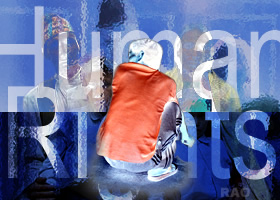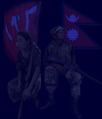|
Reports
on Nepal's Civil War
|
|
Nepal
Red Cross saving lives in conflict
|
 |
KATHMANDU,
16 March 2006 (NRCS)
By
Khem Aryal, Information Officer, Nepal Red Cross
Volunteers
of the Nepal Red Cross Society (NRCS) have become first responders after
the clashes between government security forces and Nepal Communist Party
- Maoists (CPN-M) fighters in the armed conflict of Nepal that started
a decade ago. The volunteers have rescued the wounded, provided them with
first aid services, taken them to hospitals, provided the affected with
emergency relief materials and raised awareness on mines and other unexploded
ordinances left at the sites of the clashes saving people from possible
dangers.
Recently,
the NRCS workers played a significant role to support the wounded, aware
the public and save lives after heavy clashes in Palpa and Nawalparasi
districts of western Nepal.
 |
| After
the clash in the beautiful city of Tansen on 31 January, the residents
of Palpa district headquarter were terrified and they could not go out
of their houses. The fire in the government buildings that was caused during
the fight was spreading threatening the nearby houses. The city streets
were full of unexploded ordinance and explosive remnants of war. Vice-President
of Nepal Red Cross, Palpa district branch, Yas Pal Shakya says "It looked
like a war zone."
"We
were the first people to go out with water buckets," says Mr. Shakya. "It
was very difficult to find any one who would dare to go out to help. The
telephone lines were dead and I could not even contact the Red Cross people,"
he adds. |
|
Mr.
Shakya, with other RC volunteers, gathered some local youths and extinguished
the fire that was about to engulf the public houses despite dire lack of
water in the city. "At least five houses would turn to ashes if it was
fifteen minutes late," a local says. The Red Cross played a coordinating
role in the rescue, says Mr. Shakya.
That
was not the end. There was a great risk of unexploded ordinances. They
could take lives of many if something was not done immediately. Namita
Bashyal, secretary of a youth circle in the city, says, "It was very dangerous
to go out. Anyone might be hurt or even lose life if timely precaution
was not taken."
The
Red Cross workers immediately started announcing from loudspeakers and
local FM radios about the danger of touching anything strange. They requested
the children not to touch anything that they did not know and told the
guardians to explain to their children about the danger of the unidentified
objects.
They
also put posters making the public aware of the consequences of touching
such objects. They also went to all the nearby villages. Mr. Shakya says,
"It was reported that there were such explosive devices in the periphery
of 11 kilometres. We went to all the sides and gave the message."
Luckily,
no one was hurt from the explosive devices in the district after that incident.
An elated Namita says, "We are happy that no one was even hurt. We feel
that we were successful."
In
an adjoining district of Nawalparasi, Red Cross workers saved many wounded
transporting them to nearby hospitals when a clash took place between the
two sides in Ramwapur area of the district. There was a heavy casualty
and there was no one to help the wounded and take care of the dead bodies.
"Red Cross went with its flag and rescued the wounded. We even took care
of the dead bodies," says Gopal Prasad Sharma, President of Sunawal sub-branch
of Nepal Red Cross. They also announced from loudspeaker about the Red
Cross presence and called anyone who was wounded and might be hiding for
fear of attack from the opposite side. The Red Cross was respected by both
the parties to the conflict. "We were allowed to work by both, so we could
perform the way we did," adds Mr. Sharma.
Danger
of the unexploded ordinances remained in the area, too. The Red Cross workers
gave message and requested the public not to touch anything new to them.
They also informed the concerned body about such dangers and helped to
dispose them. Mr. Sharma says, "We have to make everyone aware of them
so that no one will have to lose life or be hurt."
The
NRCS Volunteers had provided similar service in Myagdi district when a
fight took place between the conflicting parties two years ago. They also
raised awareness about the unexploded explosives and mines and saved many
people from the danger. Similarly, they provided life saving services to
the conflict victims in Chitwan last year when a bomb hit a public bus
killing more than three dozens and wounding much more.
Since
the conflict started in Nepal, the NRCS has been providing humanitarian
service to the conflict affected people in the capacity of a neutral and
impartial humanitarian organisation. The NRCS has developed into an organisation
able to address humanitarian needs in times of conflict. Cooperation Delegate
of the ICRC Valerie Dourdin says, "Training Red Cross volunteers in conflict
response, Mine Risk Education and dissemination of the Red Cross principles
are key elements to increase the NRCS readiness to respond to the need
of the victims of the ongoing conflict." Namita says, "The Mine Risk Education
(MRE) programme that started in our district eight months ago paid off
this
time."
Volunteers
at all levels are confident that they can provide service to needy people
at all times. Mr. Sharma says, "We have the capacity to work in conflict.
The recent incident is an example that we can do."
Source:
Nepal Red Cross Society2006
.

|






